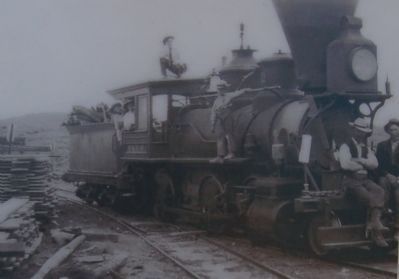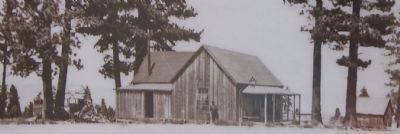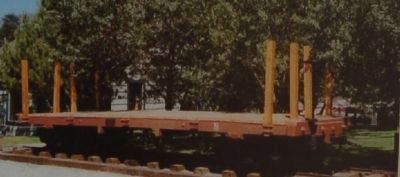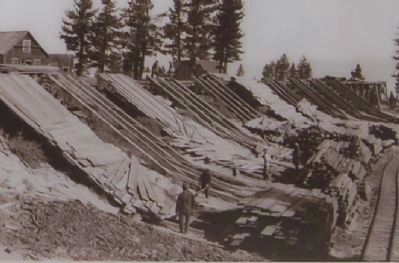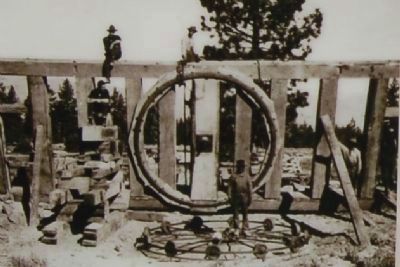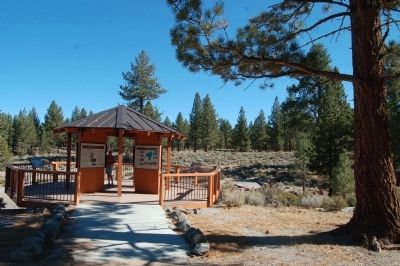Near Lee Vining in Mono County, California — The American West (Pacific Coastal)
Mono Mills
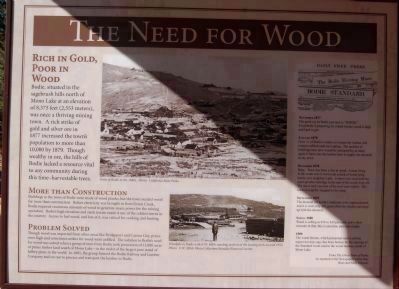
Photographed By Barry Swackhamer, October 23, 2011
1. The Need for Wood - Panel 1
Click on image of enlarge.
[Photo captions:]
[Top] - Town of Bodie in the 18802. Photo: California State Parks
[Bottom] - Wood pile in Bodie with E.W. Billib standing in front of the loading dock around 1912.
Photo: E.W. Billeb Photo Collection/Nevada Historical Society
[Photo captions:]
[Top] - Town of Bodie in the 18802. Photo: California State Parks
[Bottom] - Wood pile in Bodie with E.W. Billib standing in front of the loading dock around 1912.
Photo: E.W. Billeb Photo Collection/Nevada Historical Society
[The kiosk at Mono Mills displays a number of history panels that collectively illustrate the history of the Bodie Railway and Lumber Company.]
[Panel 1]
Bodie, situated in the sagebrush hills north of Mono Lake at an elevation of 8,375 feet (2,553 meters), was once a thriving mining town. A rich strike of gold and silver ore in 1877 increased the town’s population to more than 10,000 by 1879. Though wealthy in ore, the hills of Bodie lacked a resource vital to any community during this time – harvestable trees.
More than Construction
Buildings in the town of Bodie were made of wood planks, but the town needed wood for more than construction. Before electricity was brought in from Green Creek, Bodie required enormous amounts of wood to generate steam power for the mining operation. Bodie’s high elevation and stark terrain made it one of the coldest towns in the country. Access to fuel wood, and lots of it, was critical for cooking and heating.
Problem Solved
Though wood was imported from other areas like Bridgeport and Carson City, prices were high and sometimes orders for wood went unfilled. The solution to Bodie’s need for wood was solved when a group of men from Bodie took possession of 12,000 acres of prime timber land south of Mono Lake – in the midst of the largest pure stand of Jeffery Pines in the world. In 1881, the group formed the Bodie Railway and Lumber Company and set out to process and transport the lumber to Bodie.
The Bodie Evening Miner
Bodie Standard
The great cry in Bodie just now is “WOOD.” Everybody is preparing for a hard winter; wood is high and hard to get.
January 1878
Over 1/3 of Bodie’s orders on Carson for lumber will remain unfilled until next spring. The number of buildings here now would be increased by as many again if there was lumber here to supply the demand at any price.
December 1878
Bang. There has been a rise in wood. A man living in the south end of town took a stick of wood lying handy on a neighbor’s pile. It burnt very well until the giant powder cartridge in the end of the wood went off. The stove and a section of the roof went with it. The wicked neighbor laughed in his sleep.
September 1879
The demand for lumber continues to be unprecedented, and it is with only still great effort the dealers can keep up with the demand.
Spring, 1880
Wood is selling at $ 18 to $20 per cord, and a short measure at that; this is extortion pure
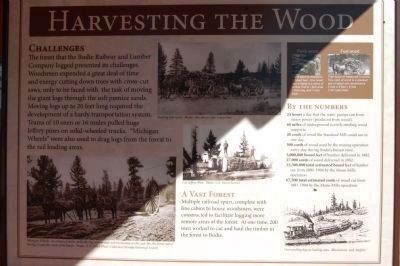
Photographed By Barry Swackhamer, October 23, 2011
2. Harvesting the Wood - Panel 2
Click on image to enlarge.
[Photo captions:]
[Bottom left] - Michigan Wheels: As a team of mules pulls the logs, lever and reel mechanism on the axle lifts the front end of the logs to ease the work on the horses.
Photo: E.W. Billeb Photo Collection/Nevada Historical Society.
[Top Center] - Hauling fuel wood.
Photo: The Mono Lake Committee.
[Bottom Center] - Cut Jeffery Pine.
Photo: U.S. Forest Service.
[Bottom Left] - Oxen pulling logs to loading area.
Illustration: Jack Moffett.
[Photo captions:]
[Bottom left] - Michigan Wheels: As a team of mules pulls the logs, lever and reel mechanism on the axle lifts the front end of the logs to ease the work on the horses.
Photo: E.W. Billeb Photo Collection/Nevada Historical Society.
[Top Center] - Hauling fuel wood.
Photo: The Mono Lake Committee.
[Bottom Center] - Cut Jeffery Pine.
Photo: U.S. Forest Service.
[Bottom Left] - Oxen pulling logs to loading area.
Illustration: Jack Moffett.
1880
The wood famine, which presented such a serious aspect ten days ago, has been broken by the opening of the Standard wood road to the wood ranches, south of Mono Lake.
From The Ghost Town of Bodie, as reported in the Newspapers of the Day. Russ and Anne Johnson
[Panel 2]
Vast Forests
Multiple railroad spurs, complete with line cabins to house woodsmen, were constructed to facilitate logging more remote areas of the forest. At one time, 200 men worked to cut and haul timber in the forest to Bodie.
By the Numbers
24 hours a day that the water pumps ran from steam power (produced from wood).
60 miles of underground tunnels needing wood supports.
20 cords
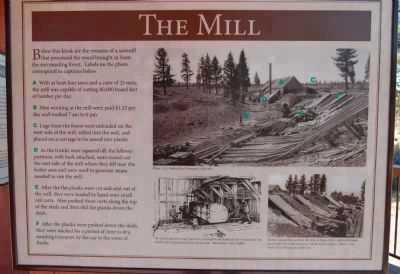
Photographed By Barry Swackhamer, October 23, 2011
3. The Mill - Panel 3
Click on image to enlarge.
[Photo captions:]
[Top:] Photo: A.A. Forbes/Paul Thompson Collection.
[Bottom Left:] The mill contained at least four saws to transform the trunks of trees into planks; one circular saw measured 54 inches in diameter.
Illustration: Jack Moffett.
[Bottom Right:] Workers organizing wood on the skids at Mono Mills. Skids held plank wood before the wood was sent to Bodie by the engines.
Photo: A.A. Forbes/Paul Thompson Collection.
[Photo captions:]
[Top:] Photo: A.A. Forbes/Paul Thompson Collection.
[Bottom Left:] The mill contained at least four saws to transform the trunks of trees into planks; one circular saw measured 54 inches in diameter.
Illustration: Jack Moffett.
[Bottom Right:] Workers organizing wood on the skids at Mono Mills. Skids held plank wood before the wood was sent to Bodie by the engines.
Photo: A.A. Forbes/Paul Thompson Collection.
300 cords of wood used by the mining operation every day during Bodie’s busiest time.
5,000,000 board feet of lumber delivered in 1882.
27,000 cords of wood delivered in 1882.
22,500,000 total estimated board feet
of lumber cut from 1881-1904 by the Mono Mill operation.
67,500 total estimated cords of wood cut from 1881-1904 by the Mono Mills operation.
[Side bar, top right]
Plank Wood
Plank wood is measured in board feet. One board foot is equal to a piece of lumber that is 1 foot wide, 1 food long, one inch thick.
Fuel wood
Fuel wood is measured in cords. One cord of wood is a stacked pile of wood with dimensions 4 feet x 4 feet x 8 feet (128 cubic feet).
[Panel 3]
A With at least four saws and a crew of 25 men, the mill was capable of cutting 80,000 board feet of lumber per day.
B Men working at the mill were paid $1.25 per day and worked 7 am to 6 pm.
C Logs from the forest were unloaded on the west side of the mill, rolled into the mill, and placed on a carriage
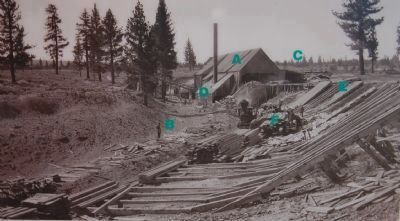
Photographed By Barry Swackhamer, October 23, 2011
4. The Mill, Detail from Mono Mill Kiosk Marker - Panel 3
Key to lettering:
A: With at least four saws and a crew of 25 men, the mill was capable of cutting 80,000 board feet of lumber per day. B: Men working at the mill were paid $1.25 per day and worked 7 am to 6 pm. C: Logs from the forest were unloaded on the west side of the mill, rolled into the mill, and placed on a carriage to be sawed into planks. D: As the trunks were squared off, the leftover portions, with bark attached, were tossed out the east side of the mill where they fell near the boiler area and were used to generate steam needed to run the mill. E: After the flat planks were cut and sent out of the mill, they were loaded by hand onto small rail carts. Men pushed these carts along the top of the skids and then slid the planks down the skids. F: After the planks were pushed down the skids they were stacked for a period of time to dry, awaiting transport by flat car to the town of Bodie.
A: With at least four saws and a crew of 25 men, the mill was capable of cutting 80,000 board feet of lumber per day. B: Men working at the mill were paid $1.25 per day and worked 7 am to 6 pm. C: Logs from the forest were unloaded on the west side of the mill, rolled into the mill, and placed on a carriage to be sawed into planks. D: As the trunks were squared off, the leftover portions, with bark attached, were tossed out the east side of the mill where they fell near the boiler area and were used to generate steam needed to run the mill. E: After the flat planks were cut and sent out of the mill, they were loaded by hand onto small rail carts. Men pushed these carts along the top of the skids and then slid the planks down the skids. F: After the planks were pushed down the skids they were stacked for a period of time to dry, awaiting transport by flat car to the town of Bodie.
D As the trunks were squared off, the leftover portions, with bark attached, were tossed out the east side of the mill where they fell near the boiler area and were used to generate steam needed to run the mill.
E After the flat planks were cut and sent out of the mill, they were loaded by hand onto small rail carts. Men pushed these carts along the top of the skids and then slid the planks down the skids.
F After the planks were pushed down the skids they were stacked for a period of time to dry, awaiting transport by flat car to the town of Bodie.
Panel 4]
A 32-mile narrow gauge (3-foot) railway connected Bodie with the Jeffery pine forest and allowed for transportation of the lumber that Bodie needed in order to increase in size. Four steam engines were brought in for this operation.
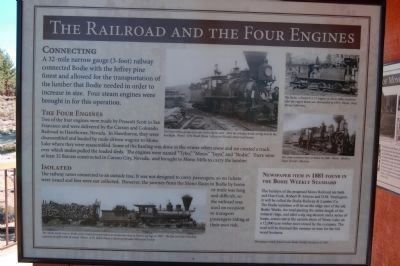
Photographed By Barry Swackhamer, October 23, 2011
5. The Railroad and the Four Engines - Panel 4
Click on image to enlarge.
[Photo captions:]
[Bottom Left]: The Mono on its way to Bodie with a load of wood makes and inspection stop at Warm Springs in 1907. The flat car had a hauling capacity of eight cords of wood.
E.W. Billeb Photo Collection/Nevada Historical Society.
[Top Left]: The Inyo with a group of people in the Bodie yard. Note the whiskey bottle sitting next to the headlight.
Photo: E.W. Billeb Photo Collection/Nevada Historical Society.
[Top Right]: The Bodie, a Porter 0-4-2T engine, at Mono Mills sometime after the engine house was dismantled in 1915.
Photo: Walt Young Collection.
[Bottom Right]: The Tybo is shown here at Bodie in 1889.
Photo: Mallory Hope Ferrell Collection
[Photo captions:]
[Bottom Left]: The Mono on its way to Bodie with a load of wood makes and inspection stop at Warm Springs in 1907. The flat car had a hauling capacity of eight cords of wood.
E.W. Billeb Photo Collection/Nevada Historical Society.
[Top Left]: The Inyo with a group of people in the Bodie yard. Note the whiskey bottle sitting next to the headlight.
Photo: E.W. Billeb Photo Collection/Nevada Historical Society.
[Top Right]: The Bodie, a Porter 0-4-2T engine, at Mono Mills sometime after the engine house was dismantled in 1915.
Photo: Walt Young Collection.
[Bottom Right]: The Tybo is shown here at Bodie in 1889.
Photo: Mallory Hope Ferrell Collection
[Side bar, bottom left]
Newspaper Item in 1881 Found in the Bodie Weekly Standard.
The builders of the proposed Mono Railroad are Seth and Dan Cook, Robert W. Graves and H,M. Yearington. It will be called the Bodie Railway and Lumber Co. The Bodie terminus will be on the ridge east of the old Bodie Works, the road passing the entire length of the mineral ridge, and after a zig zag descent and a series of loops, comes out at the eastern shore of Mono Lake on a 12,000 acre timber tract owned by the company. The road will be finished this summer in time for the fall wood business. Newspaper article found in the Bodie Weekly Standard in 1881
[Panel 5]
In 1881, a lumber community was established
here to harvest the forest and transport wood to Bodie. The sawmill quickly began producing ties for railroad construction and by November of 1881, a 32-mile narrow gauge (3-foot) railway was built to link the timberland to Bodie. Steam engines were brought in to transport the wood, and the community of Mono Mills grew to support Bodie’s need for wood.
The People of Mono Mills
By the end of 1882, there were two boarding houses and 30 small houses. Residents of Mono Mills were millworkers, railroad maintenance workers, loggers, mule teamsters, cooks and laundry workers. Chinese and Kutzakida Indians joined white settlers to support the lumber operations. The community spread into the forest to support remote logging operations. At its height, over 200 people were involved in the operation of Mono Mills.
[Panel 6]
Bodie’s success in mining translated into more business for Mono Mills, but the opposite also held true. When a rapid decrease in production from the Bodie’s mines occurred in the late 1880’s, Mono Mills was forced to stop cutting and milling wood in 1890. The mill closed for three years until an increase in production at Bodie called for the saw to run once again.
A New Source of Power
A hydroelectric power plant at
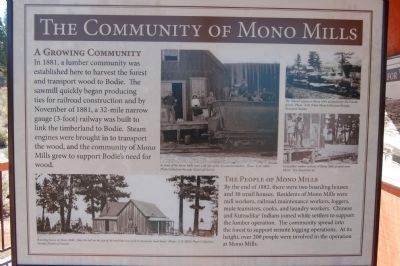
Photographed By Barry Swackhamer, October 23, 2011
7. The Community of Mono Mills - Panel 5
Click on image to enlarge.
[Photo captions:]
[Bottom Left]: Boarding house at Mono Mills. Note the bell on the top of the roof that was used to announce meal times.
Photo: E.W. Billeb Photo Collection/Nevada Historical Society
[Center]: In front of the Mono Mills store with one of the locomotive tenders.
Photo: E.W. Billeb Photo Collection/Nevada Historical Society
[Top Right]: The “Mono” engine at Mono Mills decorated for the Fourth of July.
Photo: E.W. Billeb Photo Collection/Nevada Historical Society
[Bottom Right] Kutzadika worker in front of Mono Mills general store.
Photo: U.S. Forest Service
[Photo captions:]
[Bottom Left]: Boarding house at Mono Mills. Note the bell on the top of the roof that was used to announce meal times.
Photo: E.W. Billeb Photo Collection/Nevada Historical Society
[Center]: In front of the Mono Mills store with one of the locomotive tenders.
Photo: E.W. Billeb Photo Collection/Nevada Historical Society
[Top Right]: The “Mono” engine at Mono Mills decorated for the Fourth of July.
Photo: E.W. Billeb Photo Collection/Nevada Historical Society
[Bottom Right] Kutzadika worker in front of Mono Mills general store.
Photo: U.S. Forest Service
More than a Board Foot
Though the sawmill no longer produces lumber from this Jeffery pine forest, today’s forest does provide a wealth of other resources and benefits. These trees offer shade and retain moisture to keep recreation users comfortable during hot summer months. They absorb carbon dioxide and emit oxygen, aiding the health of our global atmosphere, hold fragile pumice soils in place; and support many unique plants, animals, and insects that depend for their survival on the Jeffery pine forest ecosystems.
Timeline of Railway
1881
February 18: Bodie Railway and Lumber Co. was organized.
May: Grading for the railway began; the maximum grade was 3.8 percent.
November 14: Last spike driven in railway between Mono Mills and Bodie.
1882
Changed name to Bodie and Benton Railway and Commercial Co.
1892
Green Creek hydroelectric plant completed, which provides electricity for Bodie.
1893
Regained title of Bodie Railway and Lumber Co.
1906
December 23:
Mono Lake Railway and Lumber Co.
1907
Mono Railway Co. and Mono Lake Lumber Co. The lumber and railroad interest were separated.
1917
September 6: Railway Abandoned.
1918
All equipment, including rails, sold for scrap iron, amounting to more that the total cost of building the original railroad.
[Panel 7]
in the Mono Basin National Forest Scenic Area
Increasingly, the role of the Forest Service is to bring people together to restore ecosystems and create recreation opportunities through on-the-ground, community-based projects. A collaborative approach builds commitment to partnership and ownership of the results and helps different groups find their common interests and leverage resources to get work done. Collaboration and partnership are the way of the future for management of our nation’s forests and grasslands.
Friends of the Bodie Railway & Lumber Company, Inc. (FBRLC) is one of many groups dedicated to preserving natural and cultural history in the Mono Basin National Forest Scenic Area and throughout the Inyo National Forest. Other groups working together in this
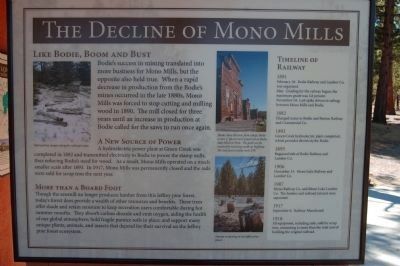
Photographed By Barry Swackhamer, October 23, 2011
9. The Decline of Mono Mills - Panel 6
Click image to enlarge.
[Photo captions:]
[Top Left]: Railroad ties remain along the railway’s route.
[Top Right]: [Bodie State Historic Park today] Bodie is now a “ghost town” preserved as Bodie Historic Park. The park can be reached by traveling north on Highway 395 and east on state route 270.
[Bottom Right]: Stumps remaining in the Jeffery pine forest.
[Photo captions:]
[Top Left]: Railroad ties remain along the railway’s route.
[Top Right]: [Bodie State Historic Park today] Bodie is now a “ghost town” preserved as Bodie Historic Park. The park can be reached by traveling north on Highway 395 and east on state route 270.
[Bottom Right]: Stumps remaining in the Jeffery pine forest.
If you are interested in assisting with the stewardship of your public lands, please visit the Mono Basin National Forest Scenic Area Visitor Center in Lee Vining or call 760-647-3044.
Friends of Bodie Railway & Lumber Company, Inc.
FBRLC is dedicated to preserving the history of the railway and the mill that were such important elements in the mining town of Bodie and the Mono Basin.
Flat Car Restoration
In 1997 one of the flat cars that ran between Bodie and Mono Mills was restored.
With the help of the Bureau of Land Management, FBRLC was able to recover remains of a flat car abandoned over 100 years ago along the old railway. Volunteer labor was focused on accurate restoration of the car. While many of the original hardware pieces were recovered, some parts needed to be replaced. All of the wood needed to be specially milled to size. Volunteers followed the design plans of the original cars built in Carson City by the Virginia and Truckee shops. After 1,200 hours of volunteer help, Flat Car # 8 was completed and dedicated at the June Lake Marina on June 29, 2002.
[Panel 8]
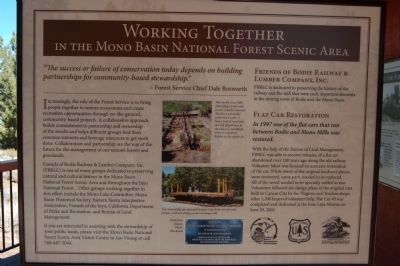
Photographed By Barry Swackhamer, October 23, 2011
10. Working Together - Panel 7
Click on image to enlarge.
[Photo captions:]
[Top]: Flat car #8, circa 1881, found flipped over with trucks (wheels) removed. The flat car probably broke down under a heavy load of wood and was left flipped over at the end of a switchback where it remained hidden in the sagebrush.
[Center]: The restored flat car, unusual because it has both side and end pockets, is shown sitting on narrow gauge rails.
[Bottom] Dedication plaque. Photo: Don Banta Eastern Sierra Interpretative Association Department of Agriculture, U.S. Forest Service
[Photo captions:]
[Top]: Flat car #8, circa 1881, found flipped over with trucks (wheels) removed. The flat car probably broke down under a heavy load of wood and was left flipped over at the end of a switchback where it remained hidden in the sagebrush.
[Center]: The restored flat car, unusual because it has both side and end pockets, is shown sitting on narrow gauge rails.
[Bottom] Dedication plaque. Photo: Don Banta Eastern Sierra Interpretative Association Department of Agriculture, U.S. Forest Service
Erected by U.S. Forest Service.
Topics. This historical marker is listed in these topic lists: Industry & Commerce • Railroads & Streetcars. A significant historical month for this entry is January 1878.
Location. 37° 53.282′ N, 118° 57.607′ W. Marker is near Lee Vining, California, in Mono County. Marker is on California Route 120, 10 miles east
of Three Flags Highway (California Highway 395), on the right when traveling west. Highway 120 is a seasonal highway and is closed during the winter. Touch for map. Marker is in this post office area: Lee Vining CA 93541, United States of America. Touch for directions.
Other nearby markers. At least 8 other markers are within 10 miles of this marker, measured as the crow flies. A different marker also named Mono Mills (a few steps from this marker); Navy Beach (approx. 4.4 miles away); West Portal (approx. 6.7 miles away); Grave of the Unknown Prospector (approx. 7.1 miles away); Legend of June Lake Slot Machines (approx. 8.4 miles away); Mono Lake (approx. 9.2 miles away); Legend of Deadman (approx. 9.6 miles away); Lee Vining (approx. 9.9 miles away). Touch for a list and map of all markers in Lee Vining.
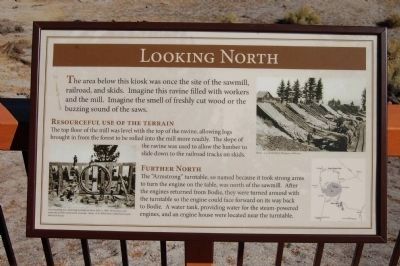
Photographed By Barry Swackhamer, October 24, 2011
12. Looking North - Panel 8
Click image to enlarge.
[Photo captions:]
[Top Right]: A.A. Forbes/ Paul Thompson Collection.
[Bottom Left]: Crew installing new Armstong turntable at Mono Mills in 1900. Shown here is the underside and the wheels of the turntable.
Photo: E.W. Billeb Photo Collection/Nevada Historical Society.
[Photo captions:]
[Top Right]: A.A. Forbes/ Paul Thompson Collection.
[Bottom Left]: Crew installing new Armstong turntable at Mono Mills in 1900. Shown here is the underside and the wheels of the turntable.
Photo: E.W. Billeb Photo Collection/Nevada Historical Society.
Credits. This page was last revised on June 16, 2016. It was originally submitted on December 3, 2011, by Barry Swackhamer of Brentwood, California. This page has been viewed 1,847 times since then and 111 times this year. Photos: 1, 2, 3, 4, 5, 6, 7, 8, 9, 10, 11, 12, 13, 14, 15. submitted on December 3, 2011, by Barry Swackhamer of Brentwood, California. • Syd Whittle was the editor who published this page.
